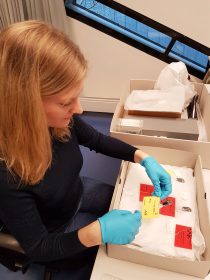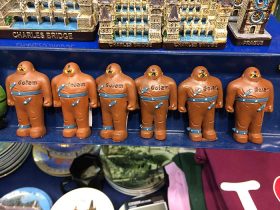Object Lessons on our Museum’s History

Trainee Lisa Renner performing inventory; Jewish Museum Berlin, photo: David Studniberg
I still remember my first day of work at the museum well, some months ago. Together with two new colleagues, I rode the elevator one floor down, we passed through two secured doors, and there we were: in the warehouse. There on two iron shelves towered bulging boxes and cartons as well as all kinds of objects — and with them, my job for the next eight months as an academic volunteer at the Jewish Museum Berlin: to set up a little special exhibition on the history of the museum itself.
Somewhat at a loss, I rummaged through a hodgepodge of exhibition papers, invitations, and photographs of people I didn’t know, and asked myself what a wire-frame goose on skateboard wheels or an old elevator sign were doing in a museum. → continue reading

Souvenir shop in Prague, 2016; photo: Katharina Schmidt-Narischkin
They’re ubiquitous in Prague souvenir shops: clunky, mechanical golem figurines that owe their popularity to the 1951 film The Emperor and the Golem. The Czechoslovakian comedy classic, called Císařův pekař a pekařův císař in the original, was conceived by Martin Frič and Jiří Krejčík as a comedy of errors with political undertones. An irascible Emperor Rudolph II and his corrupt court are searching alternately for an elixir of youth and a recipe to turn lead into gold. But above all they want to find the legendary golem. This is the missing piece in the emperor’s cabinet of wonders and curiosities. On the search for the golem a brilliant switch takes place between Rudolf and his imperial baker, Matej. It’s an exchange from which both can profit in their different ways: → continue reading

